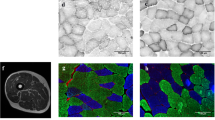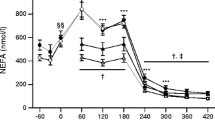Summary
Peripheral adaptations to 3 months of physical endurance training without food restrictions were studied in skeletal muscles of 14, middle-aged, physically untrained, obese women.
In comparison to aged-matched controls of normal weight, the obese group showed significantly lower isometric endurance. In the obese group, physical training resulted in a significant increase of maximal isometric and isokinetic strength. Isokinetic but not isometric endurance also increased after training. The isometric strength of obese women showed a positive correlation with the percentage of FTb fibres.
The training (50 min/day, 3 days/w) did not result in any change in body weight, body fat, and the number and weight of fat cells. The 20% increase of\(\dot V_{{\text{O}}_{\text{2}} {\text{max}}}\) after training was found to be significantly correlated with the increase in the number of capillaries around muscle fibres. The relative percentage of FTa fibres, the number of capillaries per fibre as well as the activities of citrate synthase, 3-hydroxy-acyl-CoA-dehydrogenase, and hexokinase showed a significant increase after training.
The concentrations of glucose during OGTT showed a trend to decrease with a significant decrease at the end glucose curve (120-min value). The concentration of insulin and C peptide and the insulin removal did not change after training. The changes in the concentration of glucose during OGTT was significantly correlated with the increase in muscle capillarization and of dynamic endurance.
Similar content being viewed by others
References
Andersen P, Henriksson J (1977) Capillary supply of the quadriceps femoris muscle of man: adaptative to exericse. J Physiol 270: 677–699
Aniansson A, Grimby G, Hedberg M, Krotkiewski M (1981) Muscle morphology, enzyme activity and muscle strength in elderly men and women. Clin Physiol 1: 73–86
Bass A, Brdiczka D, Eyer P, Hofer S, Pette D (1969) Metabolic differentiation of distinct muscle types at the level of enzymatic organisation. Eur J Biochem 101: 198–206
Björntorp P, de Jounge K, Sjöström L, Sullivan L (1970) The effect of physical training on insulin production in obesity. Metabolism 19: 631–638
Björntorp P, de Jounge K, Sjöström L, Sullivan L (1973a) Physical training in human obesity II. Effects on plasma insulin in glucose intolerant subjects without marked hyperinsulinemia. Scand J Clin Lab Invest 32: 41–45
Björntorp P, de Jounge, Krotkiewski M, Sullivan L, Sjöström L, Stenberg J (1973b) Physical training in human obesity III. Effects of long term physical training on body composition. Metabolism 22: 1467–1475
Borg G (1970) Perceived exertion as an indicator of somatic stress. Scand J Rehab Med 2–3: 92–98
Carlson LA (1959) Determination of serum glycerides. Acta Soc Med Upsal 64: 208–213
Cramér K, Isaksson B (1959) An evaluation of the Theorell method for the determination of total serum cholesterol. Scand J Clin Lab Invest 11: 213–216
Dubowitz V, Brooke MH (1973) Muscle Biopsy: A modern approach. In the series Major Problems in Neurology, vol 2. WB Saunders Co, Ltd, London
Elbel ER (1949) Relationship between leg strength, leg endurance and other body measurements. J Appl Physiol 2: 187–207
Forbes GB, Gallup J, Hurch JB (1961) Estimation of total body fat from potassium-40 content. Science 133: 101
Gomori G (1941) Distribution of phosphatase in normal organs and tissues. J Cell Physiol 17: 71–83
Jones HE (1947) The relationship of strength to physique. Am J Physical Anthrop 5: 29–39
Josenhans WCT (1962) Physical fitness, muscle force and endurance of male adults of over-weight. Int Z Angew Physiol Arbeitsphysiol 19: 173–182
Karlsson J (1971) Lactate and phosphagen concentration in working muscle of man. Acta Physiol Scand [Suppl] 358: 81: 1–72
Krotkiewski M, Sjöström L, Björntorp P (1977) Adipose tissue cellularity in relation to prognosis for weight reduction. Int J Obesity 1: 395–416
Krotkiewski M, Mandroukas K, Sjöström L, Sullivan S, Wetterqvist H, Björntorp P (1979) Effects of long term physical training on body fat, metabolism and blood pressure in obesity. Metabolism 28: 650–658
Krotkiewski M, Sjöström L, Björntorp P (1980a) Physical training in hyperplastic obesity. Effects of atropine on plasma insulin. Int J Obesity 4: 49–56
Krotkiewski M, Smith U, Björntorp P, Sjöström L, Morgan L (1980b) The effects of physical training on plasma insulin and gastric inhibitory polypeptide (GIP) in obese subjects. Proceedings of the Third Intern Congress on Obesity, Rome, pp 296
Krotkiewski M (1984a) Physical training in the prophylaxis and treatment of obesity, hypertension and diabetes. Scand J Rehab Med [Suppl] 9: 55–70
Krotkiewski M, Björntorp P, Holm G (1984b) Effect of physical training on insulin removal in obesity and diabetes type II. Diabetes [in press]
Krotkiewski M, Smith U, Björntorp P, Holm G, Mandroukas K (1984c) The effects of physical training in patients with obesity and impaired glucose tolerance and diabetes type II. Diabetologia [in press]
Krotkiewski M, Lönnroth P, Smith U, Holm G (1984d) The effect of physical training on insulin resistance in obesity and diabetes type II. Diabetes [in press]
Krotkiewski M, Bylund-Fellenius AC, Holm J, Björntorp P, Grimby G, Mandroukas K (1983e) Relationship between muscle morphology and metabolism in obese women: the effects of long-term physical training. Eur J Clin Invest 13: 5–12
Levin K, Linde S (1962) Determination of glucose in blood, cerebrospinal fluid and urine with a new glucose-oxidase reagent. J Swedish Med Ass 59: 3016–3026
Lowry OH, Passonneau JV (1972) A flexible system of enzymatic analysis. Academic Press, New York
Lowry OH, Rosenbrough NJ, Farr AL, Randall RJ (1951) Protein measurement with the Folin phenol reagent. J Biol Chem 193: 265–275
Lönnroth P, Di Girolamo M, Krotkiewski M, Smith U (1983) Insulin binding and responsiveness in fat cells from patients with reduced glucose tolerance and type II diabetes. Diabetes 32: 748–754
Novikoff AB, Shin WY, Drucker J (1961) Mitochondrial localization of oxidative enzymes: Staining results with two tetrazolium salts. J Biophys Biochem Cytol 9: 47–61
Nygaard E (1981) Skeletal muscle fibre characteristics in young women. Acta Physiol Scand 112: 299–304
Padykula HA, Herman E (1955) The specificity of the histochemical methods of adenosine triphosphatase. J Histochem Cytochem 3: 170–195
Petrofsky JS, Lind AR (1975) The relationship of body fat to deep muscle temperature and isometric endurance in man. Clin Sci Molec Med 48: 405–412
Saltin B, Henriksson J, Nygaard E, Andersen P, Jansson E (1977) Fibre types and metabolic potentials of skeletal muscles in sedentary man and endurance runners. Ann NY Acad Sci 301: 3–29
Sjöström L, Björntorp P, Vrana J (1971) Microscopic fat cell size measurement on frozen cut adipose tissue in comparison with automatic determinations of osmiumfixed fat cells. J Lipid Res 12: 521–530
Sullivan L (1976) The effects of exercise in hyperplastic obesity with special reference to physical performance and hyperinsulinemia. Scand J Rehab Med [Suppl 5] pp 1–25
Sullivan L, Bjurö T, Krotkiewski M (1981) Physical training in obese subjects. In: Björntorp P, Cairella M, Howard AN (eds) Recent advances in obesity, Research III. London, pp 307–314
Author information
Authors and Affiliations
Rights and permissions
About this article
Cite this article
Mandroukas, K., Krotkiewski, M., Hedberg, M. et al. Physical training in obese women. Europ. J. Appl. Physiol. 52, 355–361 (1984). https://doi.org/10.1007/BF00943363
Accepted:
Issue Date:
DOI: https://doi.org/10.1007/BF00943363




